Sedum Vidny - description and rules of cultivation
Autumn flower, or sedum Vidny - a perennial succulent plant native to Eastern China, Japan and Korea, has many bright and original varieties. All of them have good endurance and take root well in any climatic zone. Consider the description of the species, its variety and the rules of care in the personal plot.
- general characteristics
- Varieties
- Karl
- Matrona
- Novem
- Iceberg
- Brilliant
- Subulate (rupestre aureum)
- Stardust
- Frosty Morne
- September glut
- Diamond Edge
- Variegata
- Purple Emperor
- Red cauli
- Xenox
- Neo (neon)
- Carmen
- Autumn fire
- Portmans Pride (postman's pride)
- Rosneteller
- Autumn joy
- Purchase and adaptation
- Landing rules
- Growing conditions
- Lighting
- Humidity
- Temperature
- Care
- Watering
- Top dressing
- Pruning
- Preparing for winter
- Transfer
- Reproduction methods
- Cuttings
- Seeds
- By dividing the bush
- Pieces of roots
- Diseases and pests
- Useful videos
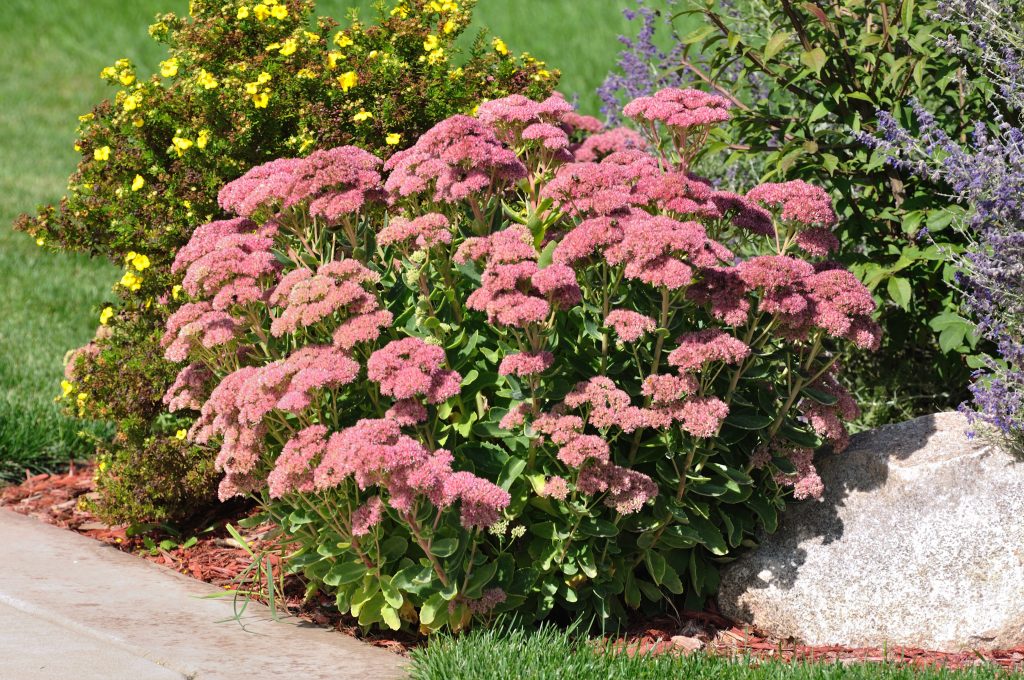
Sedum prominent varieties
general characteristics
The sedum is also called sedum. The botanical name for the variety in Latin is sedum spectabile. The plant is part of the Tolstyankovye family.
Description:
- medium-sized culture with a height of 35 to 80 cm, depending on the variety;
- the buds are large, luxurious, can reach 25 cm in diameter;
- inflorescences are pink, lilac, purple, purple and white.
Blooms early - already in the first half of May.
This plant is valued for its beneficial properties, because it contains a large amount of vitamins, minerals and trace elements.
Leaves and stems have an analgesic and hemostatic effect. It has a positive and calming effect on the central nervous system. Helps to cope with colds and lung diseases.
Varieties
This species has many colorful and attractive varieties that are readily used in landscape design.
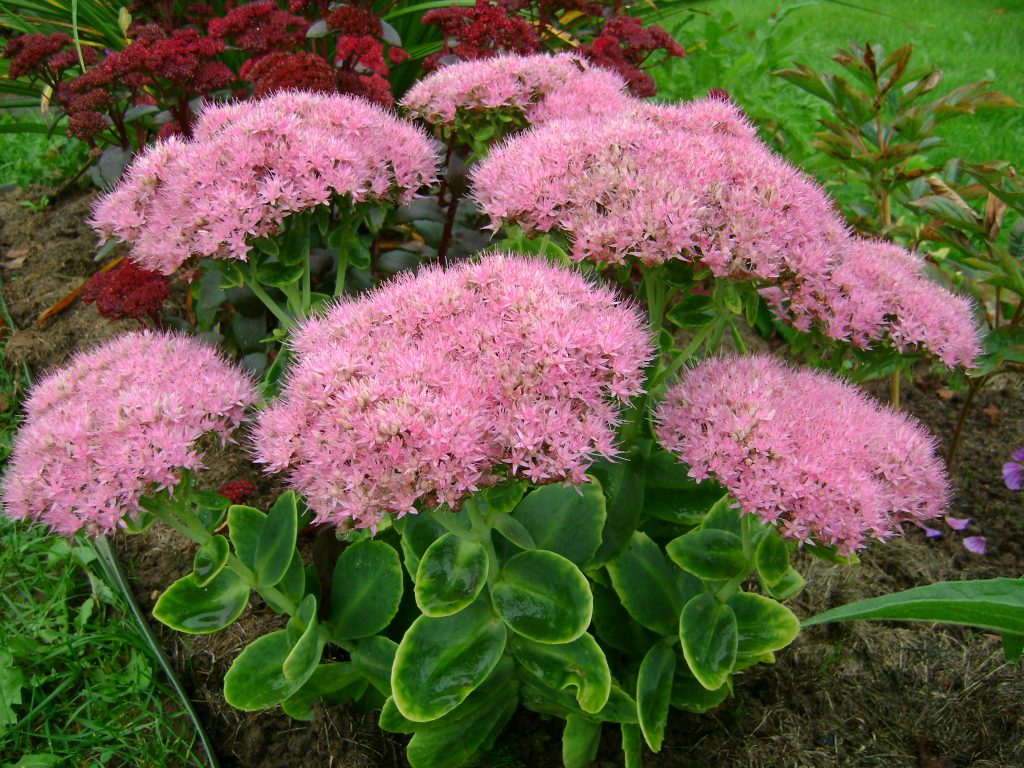
Chitok is prominent in landscape design
After reviewing them, you can choose the most suitable variety for decorating your garden.
Karl
A beautiful plant with strong, upright shoots reaching 50 cm in height. Leaves are oval, with a smooth surface, develop alternately.
At the top of the stems, bright pink small flowers are formed, collected in umbrella inflorescences. The flowering period lasts from late August to early October.
Matrona
This shrub can reach 60 cm in height and has good frost resistance.
It is valued for its lush and long flowering, which lasts from mid-August to late autumn. The flowers are pink-red, large - up to 25 cm in circumference, framed by dense, emerald leaves with a glossy surface.
New (novem)
A colorful perennial with pink and purple leaves, height about 35 cm. It has a tuberous root system and bluish-green leaves, which develop in whorls of 3-4 pieces.
The variety is distinguished by original flowers of pink-lilac or carmine-purple hue, collected in umbrellas.
Flowering lasts a little more than a month, begins in the first decade of September.
Iceberg
It is distinguished by delicate white inflorescences reaching 15 cm in diameter. Against the background of an autumn flower garden, snow-white buds look like pieces of ice - hence the name iceberg.
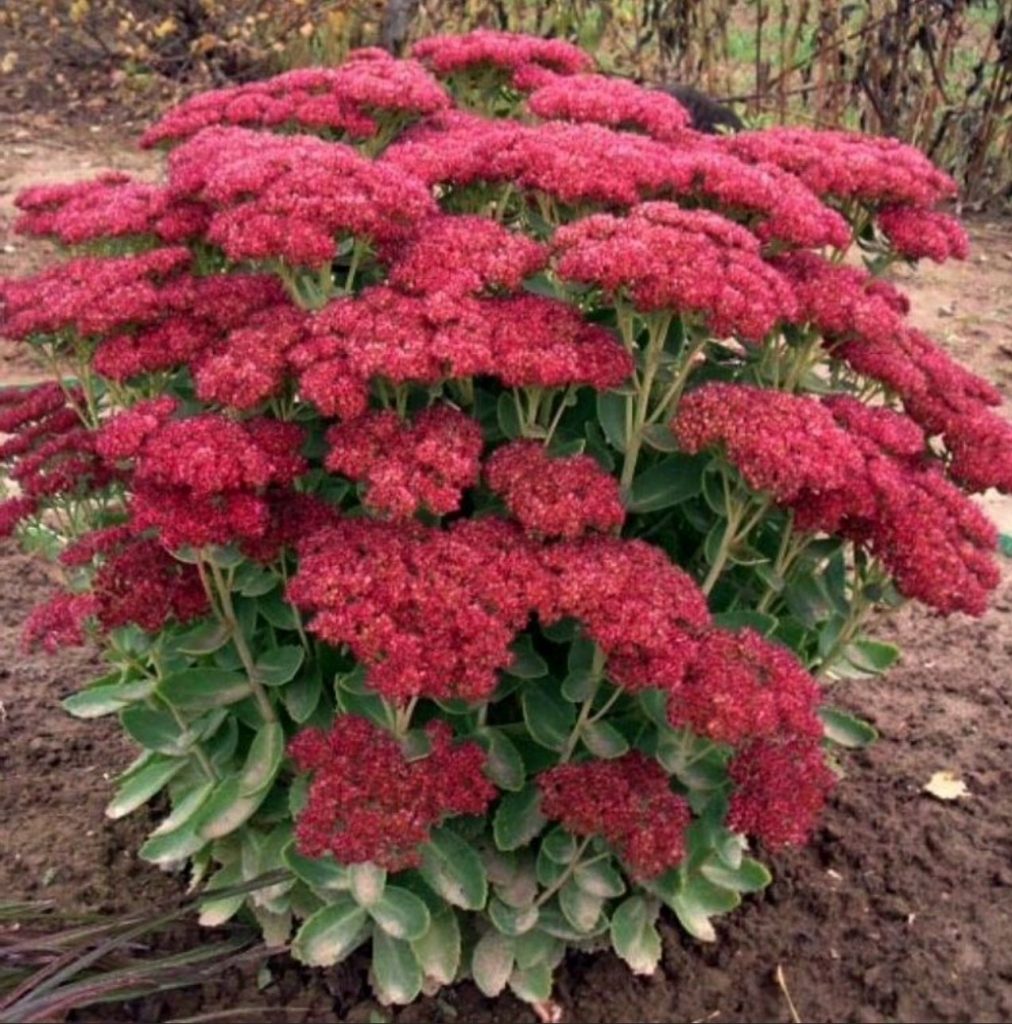
Sedum sedum spectabile brilliant
The plant is compact - up to 15 cm in height, consists of numerous erect shoots, covered with light green, dense oval leaves.
The variety blooms in the last decade of August, blooms in early November.
Brilliant
One of the oldest species, which was bred in 1913. It has massive, thick, erect stems and a thickened root system.
On one bush, from 15 to 20 shoots can form, up to 50 cm long. In the flowering phase, it forms lush, spreading buds with a circle of 25 cm.The color is pinkish-red, it becomes more saturated closer to the center.
Flowering occurs at the end of August and ends in the first half of November.
Subulate (rupestre aureum)
Differs in miniature size - height 15 cm. Shoots are densely covered with thick, needle-like leaves of golden yellow color.
In the flowering phase, the bush forms an arrow up to 20 cm long. Beautiful yellow flowers, collected in shields, bloom at its top.
The sedum with age builds up a dense green mass, which forms a dense coniferous carpet.
Stardust
Medium-sized ornamental culture 40-60 cm high with erect stems, densely covered along the entire length with oval, glossy leaves. At the top of the shoots, small white flowers are formed, resembling snowflakes in appearance.
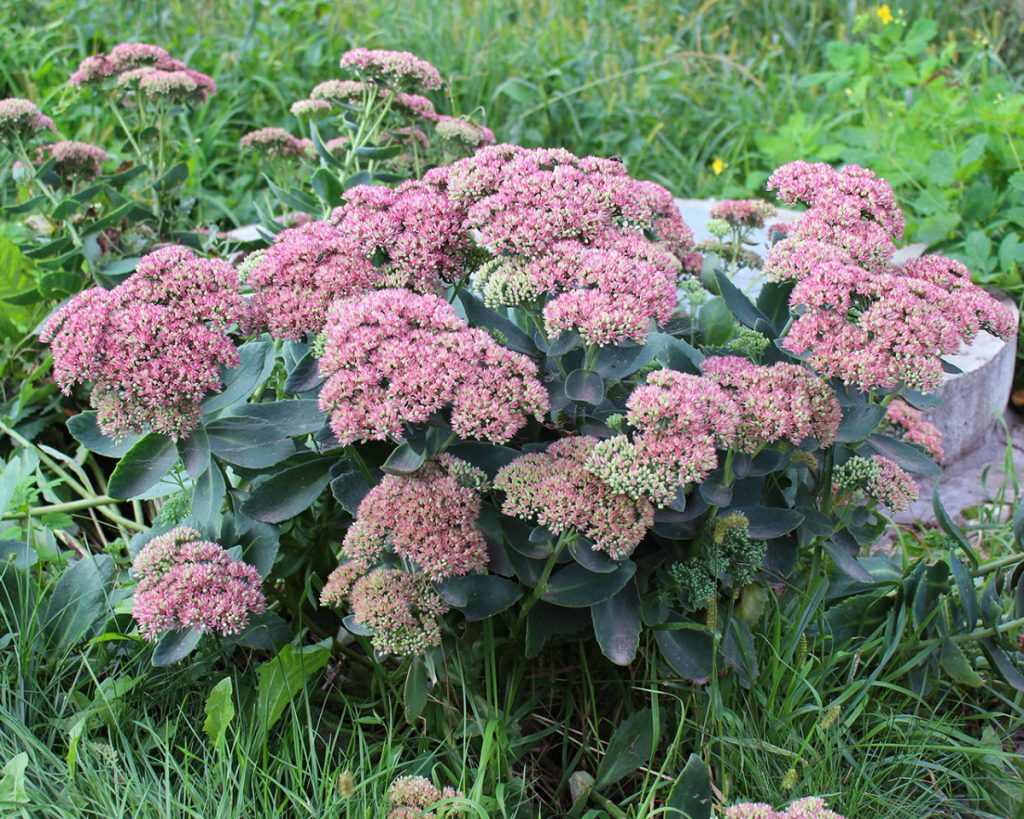
Sedum prominent breeding
Flowering occurs in late August or early September. It is characterized by increased frost resistance, therefore it is suitable for cultivation in harsh climatic conditions.
Frosty Morne
This plant has beautiful flowers and leaves. An oval and smooth leaf blade in a light green tone contains a snow-white edging. The length of the leaves is 5-7 cm.
The variety has a compact size - height 30-35 cm. It blooms with white small flowers at the end of summer.
September glut
Ornamental perennial with vertically growing shoots up to 0.5 m high. The tops of the stems are decorated with pale pink inflorescences with a diameter of 20-25 cm. The leaves are ovoid, with a glossy surface, of a green tone with a bluish tint.
It blooms in the last decade of August and retains its beauty until the first frost.
Diamond Edge
Decorative blooming stonecrop is distinguished by beautiful erect stems of a reddish tone, up to 50 cm high. Over the entire surface, the shoots are densely covered with dense, oval leaves of an emerald tone with a burgundy tint and cream edging.

Sedum prominent pink
Blossoms with light pink inflorescences. The buds bloom in the last decade of August. Duration of flowering is 1.5-2 months.
Variegata
The hybrid variety is not very tall (45-50 cm). The stems are juicy and grow upright. Abundantly covered with dense, smooth oval leaves, white-green hue.
During the flowering period, the variety pleases with beautiful pale pink flowers, which retain decorative properties for 2-2.5 months. The buds open at the end of summer.
Purple Emperor
Translated from English means the purple emperor. This flower is decorative and differs in many respects from other species - the leaves are dense, oval.
Stems are erect, burgundy. One of the largest varieties - the bush reaches 60 cm in height, 80 cm in width. At the top of the shoots, many small buds are formed, collected in bunches of inflorescences.
The flowers are pink and blend beautifully with purple foliage. Blossom in late August and ends in late autumn. Due to its long flowering, the plant has gained great popularity in landscape design.
Red cauli
A very beautiful hybrid with tough stems covered along the entire length with gray-blue foliage. It blooms in mid-July, the buds remain decorative until the first half of September.
Flowers of a deep red hue, collected in shields. This crop prefers to grow in a sunny location, and it can also be planted in an area with light shading.
Xenox (xenox)
One of the most popular ornamental shrubs with fleshy purple leaves. The length of the leaf plate is 5-7 cm. The inflorescences are the same tone as the leaves.
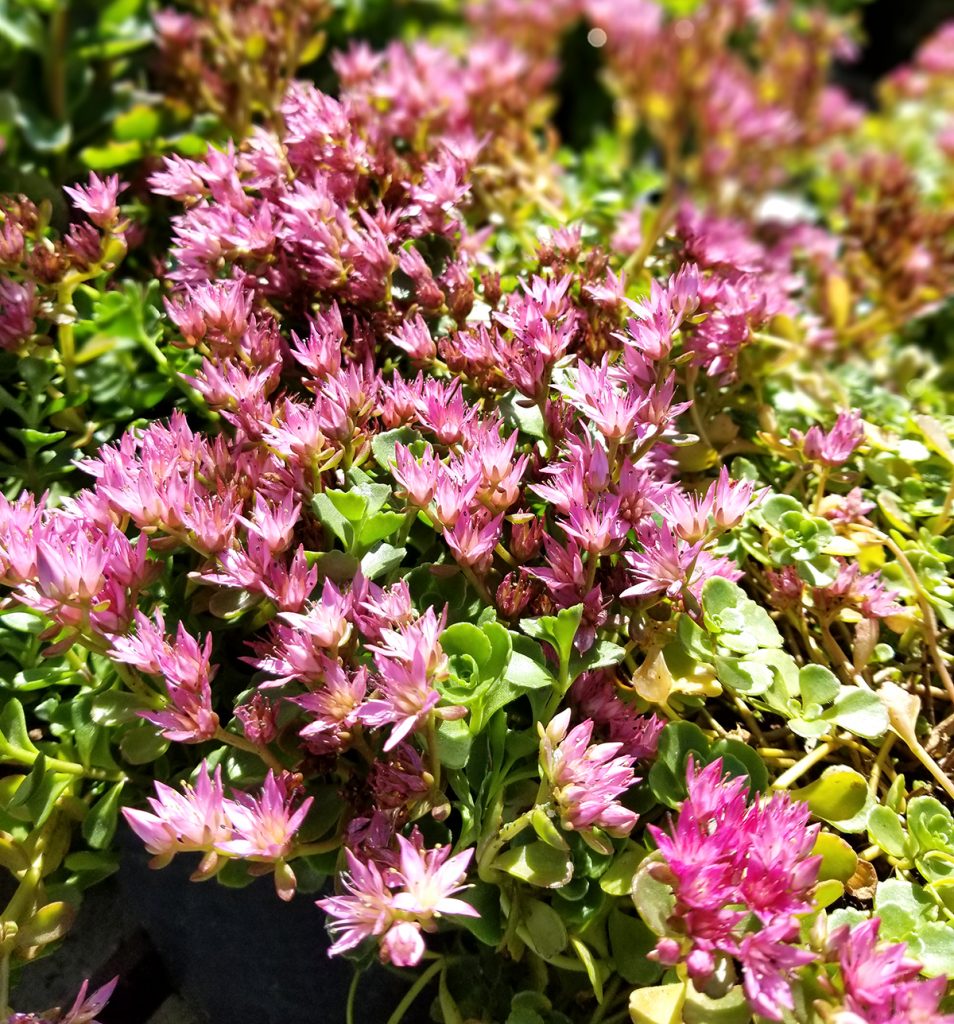
Sedum prominent planting and care photos
The flowering period is July-October. This culture is appreciated not only for its decorative effect, but also for its compact size - a height of 30-35 cm. Therefore, it is excellent for growing in mixborders.
Neo (neon)
Sprawling shrub with a lush crown, height about 60 cm. The plant is light-loving and drought-resistant. The color of oval and dense leaves is different depending on the season - during the growing season it is gray-green, in autumn it changes to red with a bronze tint.
It blooms in August and ends in October. False umbrella inflorescences consist of small lilac-pink flowers.
Carmen
A dense shrub with a height of 0.5 m and a circumference of 0.3 m, consists of thick, vertically growing shoots of a burgundy tone. All over the stems are covered with emerald foliage with a red vein in the center.
Long bloom - from August to October. Deep pink buds attract bees.
Autumn fire
The variety is decorative - forms green shoots, reaching 0.5 m in height, covered with emerald leaves with a bluish tint.
During the flowering period, forms capitate inflorescences of a pinkish-copper hue. Flowering lasts from late summer to late autumn.
The plant is not afraid of severe frosts, therefore, it does not need to be covered before winter.
Portmans Pride (postman's pride)
A medium-sized shrub, weakly branched, forms stems up to 60 cm high. Thick, ovoid leaves of a purple-brown hue develop over the entire surface of the shoots.
It blooms in the first half of September - the inflorescences are pink, look tender against the background of dark foliage.
Rosneteller
Shrub species up to 40 to 60 cm high. Stems are erect, oval leaves, develop along the entire length of the shoots. One of the most decorative early flowering varieties, which pleases with bright colors already at the beginning of May.

Sedum prominent photo
Flowers of a lingonberry-pink shade, collected in half-umbrellas, bloom at the top of the stems.
After flowering, forms small fruits, in which the seeds ripen.
Autumn Joy (autumn joy)
Translated from English means - autumn joy. The sedum reaches a height of 50 cm. Stems are thick, erect. The leaves are dense, oval, green.
The variety blooms with dark crimson buds, which are formed at the top of the shoots and are collected in umbrella-shaped inflorescences.
Purchase and adaptation
If you want to purchase one of the varieties described above, you should go to a florist shop to purchase. You can buy both seed and already grown perennial seedlings.
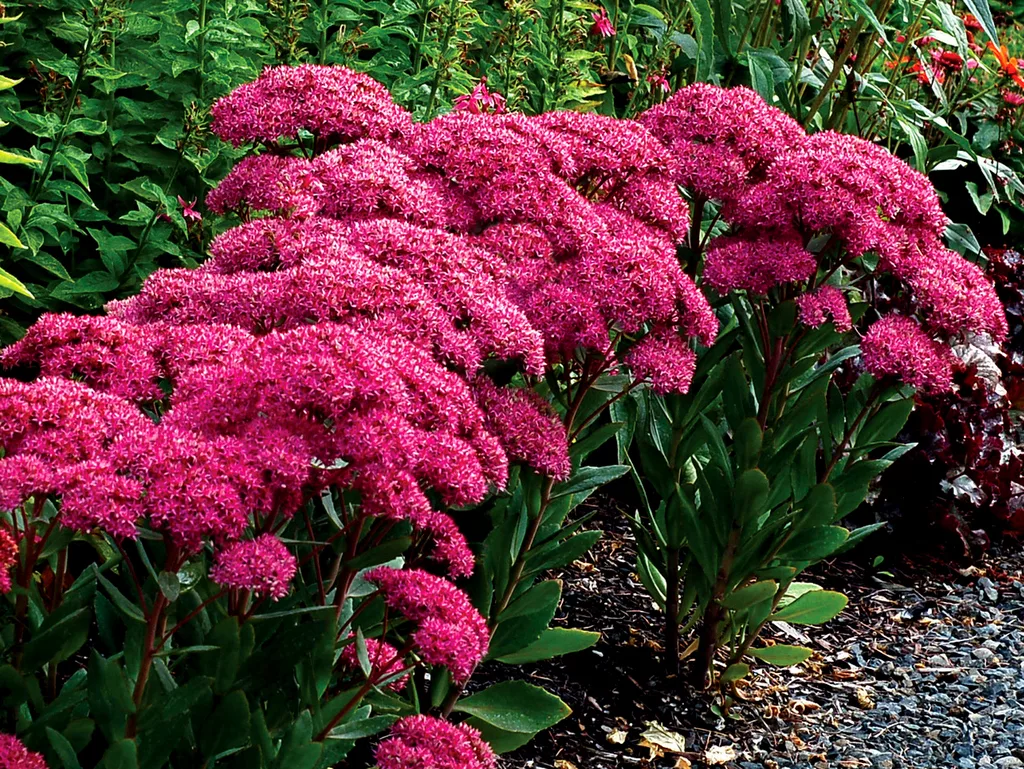
Sedum prominent landing
When buying seeds, pay attention that their expiration date is valid.
If you are purchasing plants in containers or pots, carefully inspect the crown. Stems and leaves should be juicy, fresh, without any signs of diseases and parasites (spots, growths, blotches of black, brown or yellow). There is no acidification and mold on the surface of the substrate.
Choose flowering specimens - so you can make sure that in front of you is exactly the variety that you would like to plant on your site.
After the purchase, the bush is kept in a three-week quarantine to eliminate the risk of contamination of other vegetation in the flower garden.
If the shrub has no health problems, they wait for it to bloom, then transplant it to a permanent place in the garden.Usually this procedure is carried out in the fall, about a month before the onset of cold weather.
Landing rules
To get a strong and abundantly flowering plant, you need to find a comfortable place in the garden - it prefers to grow in a sunny area, where there are no winds and scorching sun.
It should be planted near the walls of the house, farm building or under tall shrubs, trees, which will provide shading at lunchtime.
The soil should be light, loose, with a neutral acidity level - 6 units. You can deacidify acidified soil with chalk, dolomite flour or hydrated lime (400 ha / m²).
The optimal composition for successful cultivation is garden soil, turf, compost and sand, mixed in a 2: 2: 1: 1 ratio.
If the soil is clay, it must be loosened with peat, sand, or perlite or vermiculite should be applied.
Growing conditions
Lighting
The plant requires at least 10 hours of diffused daylight per day throughout the growing season.
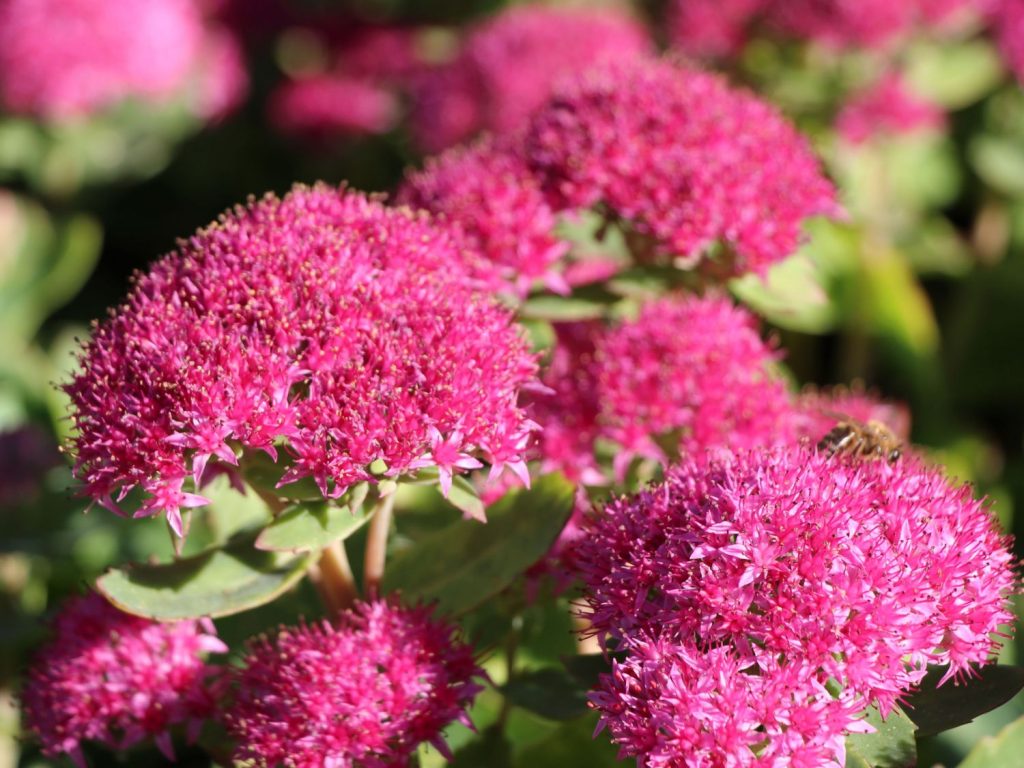
Sedum prominent planting and care
If this condition is not met, the bush will stop growing, the shoots will begin to stretch, and the flowering will be scarce and not so bright.
Therefore, they choose a place for landing where the sun shines in the morning and evening.
Humidity
The culture responds positively to the frequent sprinkling of the crown. In spring and summer, this procedure is carried out once a week; on too hot days, it is irrigated every day. It is necessary to spray in the evening to avoid burning the foliage and buds.
With the arrival of autumn, sprinkling is stopped, because when the temperature drops, the bush will not dry out, which can lead to rotting of the entire crown.
Temperature
Comfortable temperature for full-fledged growth and flowering is 20-27 ° С.
Almost all types of stonecrop have good frost resistance, therefore they easily endure the most severe frosts - lowering to -35 ° C. They can be safely grown in areas of risky farming with harsh winters.
Care
Watering
The sedum is drought-resistant - the lack of moisture is replenished by succulent leaves and stems. But if you want to achieve a lush and bright flowering from a plant, you need to water it regularly.
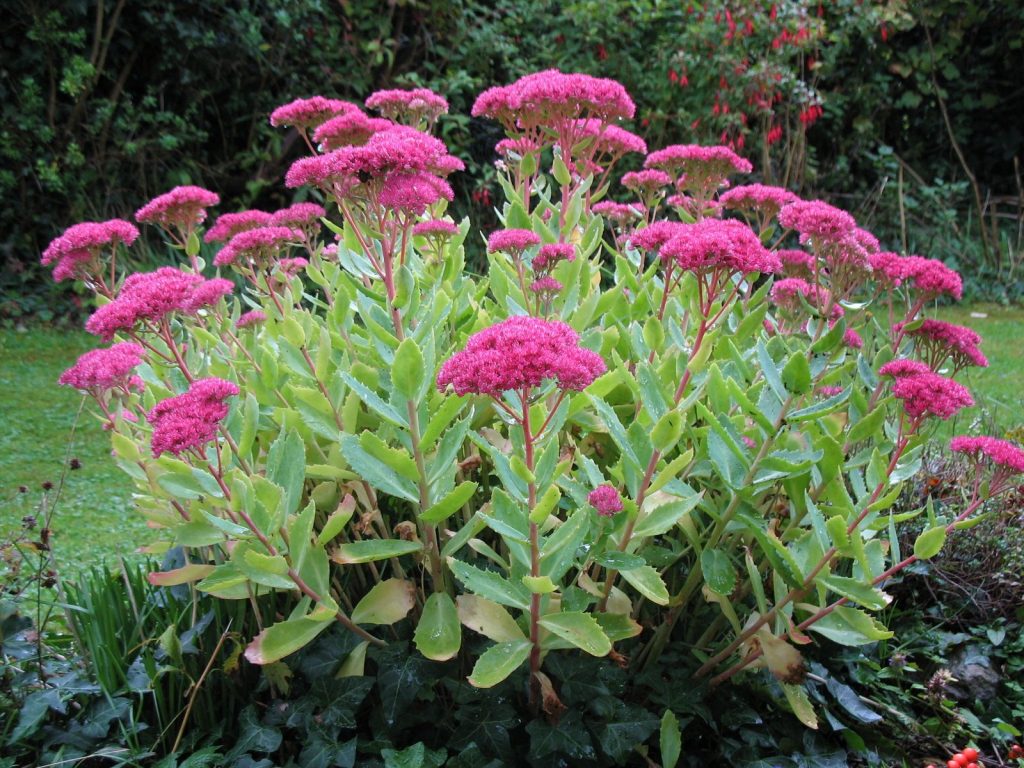
How to propagate stonecrop
Throughout the growing season, they are moistened every 7 days, if there is no precipitation. At the stage of laying flower buds, the frequency is increased - every three days. This will increase the decorative properties.
Closer to the autumn cold, moisture is minimized - once every two weeks, 10 days before the first frost, watering is excluded in order to prevent freezing of the root system.
It is necessary to use warm water, water only in the evening to avoid burns on the crown. Light loosening is recommended after watering to maintain moisture and breathability. The near-trunk zone can be mulched with peat or last year's manure so that the moisture does not evaporate quickly.
Additionally, periodic weeding is carried out between the rows, weeds are removed, which are an excellent medium for the appearance of parasites and infections.
Top dressing
If compost or last year's manure was introduced into the soil during planting, food will not be required for the next two years.
Shrubs growing on poor land, before and after flowering, it is advisable to feed with a liquid complex composition. Suitable preparations for succulents, which can be purchased at a flower shop.
Pruning
This perennial does not need shaping. Throughout the growing season, only those parts that have been broken off, dried out or damaged by diseases and pests are cut out.
After the end of flowering, dried inflorescences are cut off so that they do not take away strength and energy from the plants.
Preparing for winter
Winter-hardy varieties do not require any preparation for winter. Shelter is required only for low-resistant crops.
Three weeks before the onset of stable cold weather, the near-trunk zone is spud with a thick layer of peat or garden soil. The crown is covered with burlap or spruce branches.
Transfer
To maintain health and decorative qualities, prominent sedum must be periodically transplanted from one place to another - once every 4-5 years.
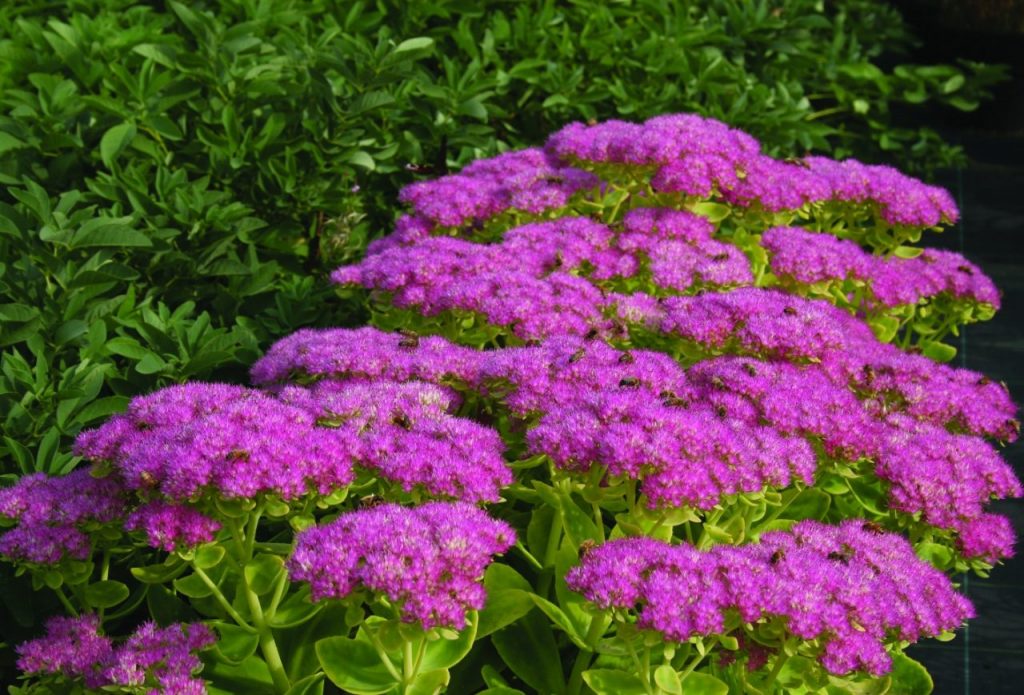
Sedum prominent matron
Usually this procedure is carried out in the spring. The site is prepared according to the same principle as for planting plants - if necessary, deacidify, add a bucket of humus or compost for 1 m², dig it up, level it.
Dig holes at a distance of 50 cm, with a distance in a row of 60 cm. The bushes are watered abundantly, dug out and transferred together with an earthen clod into the holes. They are covered with earth, tamped, moistened, mulched with peat.
Reproduction methods
There are several ways to propagate a perennial shrub, each with a specific technology.
Cuttings
Cutting is one of the most popular and justified ways in which you can get strong bushes with all the varietal characteristics of the mother plant.
They start harvesting shoots from the top of a healthy bush in spring or summer.
- Cuttings are cut with a sterile secateurs, the optimal length is 12-15 cm.
- In the lower part, all the foliage is removed, placed in a vessel with water and kept until they release the roots. This usually takes 1-2 weeks.
- Cuttings are planted in the open field in a sunny place with a little shading at lunchtime. The soil is prepared the same as when planting adult specimens.
- In the first weeks, they are watered every other day in order to stimulate the rapid establishment and growth of green mass.
Seeds
The sedum plant reproduces by seeds, but this method does not always give the expected result.
Seeds are sown in spring in shallow containers filled with peat and sand (1: 1), irrigated with warm water, covered with foil.
Keep at a temperature of 23-25 ° C, periodically ventilate, moisten.
After the emergence of sprouts, the shelter is removed, and at the stage of development, 1-2 leaves are seated in separate pots. They are grown at home for another month, then they are planted in the open field.
By dividing the bush
This breeding method is used when you need to rejuvenate an old bush. It is watered abundantly, dug up, dipped in a container of water to wash the soil from the roots.
Divide the root system into several parts. Each should have one shoot and 2-3 roots.
Places of cuts are sprinkled with charcoal, dried, planted, keeping a distance between the seedlings of 50-60 cm.
Pieces of roots
Such reproduction allows you to get several new copies at the same time. Usually, this method is used for rotting of the root system, when the plant can no longer be saved, but young seedlings can be grown from the remnants of viable roots.
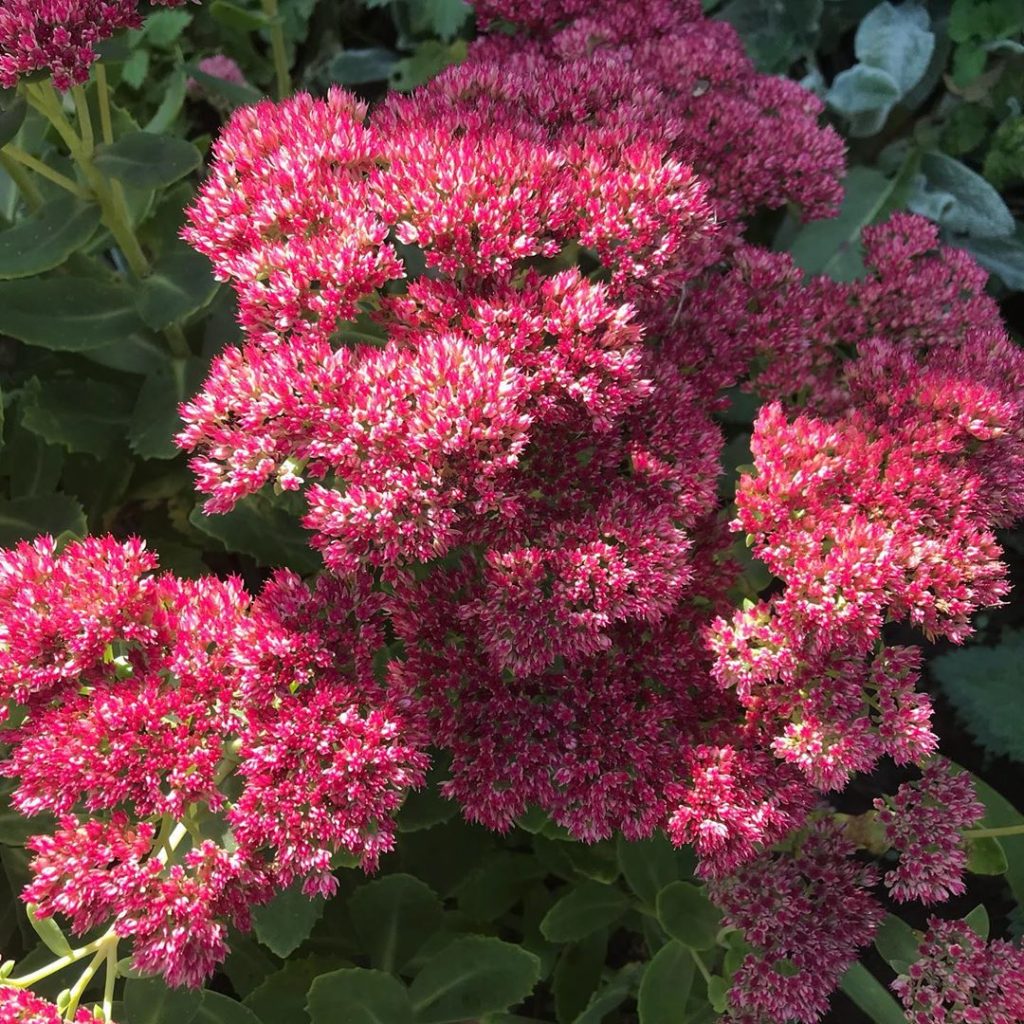
Sedum prominent iceberg
The bush is moistened, dug out, healthy shoots are cut off, divided into parts 4-5 cm long, treated with fungicides. After five hours of drying, they are planted in fertile and loose soil, watered.
Diseases and pests
Throughout the year, sedum can be invaded by various parasites and sore pathogens.
| Diseases and pests | Signs | Treatment methods | Prophylaxis |
| Aphid | It feeds on the juice of foliage, kidneys, young shoots. Affected organs turn yellow, dry out, leaves curl | Insecticide treatment used in the treatment of black currant | Regular weeding, removal of weeds, adherence to the planting scheme |
| May Khrushch | The larvae of this pest eat the roots, which leads to wilting, then drying out of the entire crown | It is impossible to save a severely affected plant, it is dug up, the soil around the bush is dug in, parasites are destroyed, the soil is spilled with a solution of copper sulfate | Treatment in early spring (late March or early April) with Antikhrushch or Prestige |
| Fungal infections | Affects the leaves - they become covered with black or brown spots | Remove all damaged foliage and burn. Treat the soil and crown with fungicides - Ridomil Gold or Fundazol | Before planting, treat the soil with a solution of copper sulfate, dig up every fall, buy healthy seeds and plants for planting on the site |

